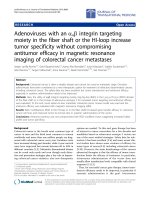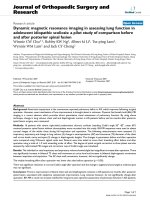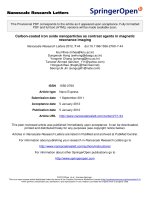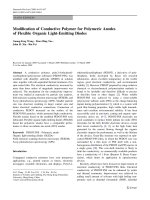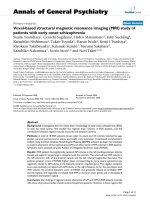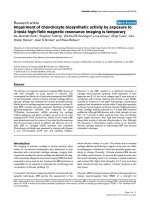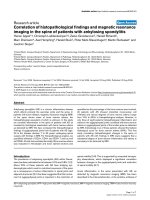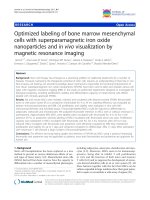Formulation of superparamagnetic iron oxides by nanoparticles of biodegradable polymer for magnetic resonance imaging (MRI)
Bạn đang xem bản rút gọn của tài liệu. Xem và tải ngay bản đầy đủ của tài liệu tại đây (1 MB, 86 trang )
FORMULATION OF SUPERPARAMAGNETIC IRON OXIDES
BY NANOPARTICLES OF BIODEGRADABLE POLYMER
FOR MAGNETIC RESONANCE IMAGING (MRI)
NG YEE WOON
(B.Eng.(Hons.), NUS)
A THESIS SUBMITTED
FOR THE DEGREE OF MASTER OF ENGINEERING NUS
NANOSCIENCE AND NANOTECHNOLOGY INITIATIVE
2006
Acknowledgements
I would like to thank NUS and EDB for awarding me the scholarship, thus making it
possible for me to pursue a postgraduate course in nanoengineering. During the past
two years, I have learnt a lot and I would take to take this chance to show my
gratitude to those who have helped me with this project in one way or another.
First and foremost, I would like to thank my supervisor A/P Feng Si-Shen for his
guidance and support. I would also like to show my appreciation to A/P Wang ShihChang and A/P Ding Jun who has helped me on the study of MRI and magnetic
properties respectively.
Next, I would like to express my gratitude to Dr. Borys Shuter for taking time to
assist me in the use of MRI machine for my experiments. I would also like to show
my appreciation to Dr. Chen Yan for her advice and encouragement.
Another important person I want to thank is Ms. Wang Yan, my fellow schoolmate,
who has extended a helping hand to me whenever I met with difficulties in my
experiments.
Last but least, I would like to thank everyone in the Chemotherapy Laboratory who
has given me help when I need them and make my life in NUS a memorable one.
i
Table of Contents
Acknowledgements
i
Table of Contents
ii
Summary
v
List of Tables
viii
List of Figures
ix
List of Symbols
xi
Chapter 1 Introduction
1
1.1
Background
1
1.2
Objectives
5
1.3
Organization of thesis
7
Chapter 2 Literature Review
8
2.1
Nanoparticles of Biodegradable Polymers
8
2.2
Introduction to MRI
13
2.3
Introduction to MRI contrast agent
16
2.4
Research done on IO encapsulated polymeric nanoparticles
20
Chapter 3 Materials and Methods
23
3.1
Materials
23
3.2
Preparation of the nanoparticles
23
3.3
Physicochemical characterization of the nanoparticles
25
3.4
MR Characterization of the nanoparticles
29
3.5
Biodistribution
30
ii
Chapter 4 Physicochemical Characterization
32
4.1
Crystalline structure and surface chemistry
32
4.2
Size Distribution and Iron loading
34
4.3
Surface Morphology
36
4.4
Surface Charge
37
4.5
Stability
38
4.6
In vitro release profile
39
4.7
Summary
40
Chapter 5 Magnetization properties
42
5.1
Characteristics of superparamagnetic materials
42
5.2
Magnetization – temperature dependence
43
5.3
Blocking temperature TB
45
5.4
Summary
47
Chapter 6 In vitro MR studies
48
6.1
Relaxivity plots
48
6.2
Qualitative analysis
51
6.3
Investigations on encapsulation effects
52
6.4
Theories behind relaxivity enhancement
54
6.5
Summary
55
Chapter 7 Animal studies
56
7.1
Biodistribution studies
56
7.2
Ex vivo MRI
57
7.3
Summary
58
iii
Chapter 8 Conclusions and Recommendations
60
8.1
Conclusions
60
8.2
Recommendations
63
References
64
iv
Summary
Magnetic resonance imaging (MRI) is an imaging technique used primarily in
medical settings to produce high quality images of the inside of the human body. Iron
oxides (IOs) which increase the R2 relaxation rate of the surrounding medium to
create signal voids on MR images, have been used as an MRI contrast agent. Their
major applications include imaging of the liver, spleen, and breast. For future
applications such as imaging of specific molecular targets to allow for earlier
recognition and characterization of disease, earlier and direct evaluation of treatment
outcomes, and a deeper understanding of disease development, there is a need to
develop special contrast agents with greater ability to amplify the MRI signals [1].
This can only be achieved if contrast agents are accumulated in the target cells by
passive endocytosis, or by active transporter systems such as transferring receptors
that shuttle contrast agents into targeted cells [2]. A feasible way of enabling active
targeting is to employ a nanoparticulate structure, which can serve as a scaffold for
targeting ligands and magnetic labels [3]. Therefore, much attention has been paid to
the research and development of nanoparticles to further enhance the contrast
efficiency of IOs.
The main objective of this project is to develop a novel formulation of MR contrast
agent by encapsulating IOs with biodegradable polymer, methoxy poly(ethylene
glycol)-poly(lactide-co-glycolide) (PLGA-mPEG). The IOs used are commercial MR
contrast agent Resovist®. The IO loaded PLGA-mPEG nanoparticles, prepared by
v
water in oil in water (w/o/w) double emulsion technique, were characterized by
several techniques including laser light scattering (LLS) for the particle size, field
emission scanning electron microscopy (FESEM) for the surface morphology,
transmission electron microscopy (TEM) for qualitative determination of IOs loaded,
inductively coupled plasma-optical emission spectroscopy (ICP-OES) and/or
inductively coupled plasma-mass spectrometer (ICP-MS) for quantitative
determination of IOs loaded, superconducting quantum interference device (SQUID)
for magnetization measurement, and MRI for contrast effect determination. In
addition, in vitro release study to determine the release kinetics profile and stability
tests to evaluate the resistance of the IO loaded PLGA-mPEG nanoparticles towards
aggregation and iron leakage upon exposure to osmotic agent NaCl (sodium chloride)
were carried out.
These nanoparticles were spherical with an average diameter of 233.0 nm and a
relatively narrow size distribution of ±12.5 nm. The iron loading was 1.37%. They
showed enhanced saturation magnetization, improved r2 and r2* relaxivities, and
increased contrast effect of both in vitro and ex vivo MR images. The feasibility of
the enhancement effect achieved can be substantiated by MR theories such as
motional averaging regime (MAR) and static dephasing regime (SDR). The signal
amplification achieved may be due to agglomeration of IOs inside the polymer
matrix.
vi
In summary, the remarkable increase in the MR contrast efficiency of the developed
IO loaded PLGA-mPEG nanoparticles over the commercial IO contrast agent
Resovist®, suggests that these nanoparticles could be potential MRI contrast agent.
vii
List of Tables
Table 3.1
The TE and TR parameters for measuring relaxivities of the IOs and
IO loaded PLGA-mPEG nanoparticles.
29
Table 4.1
Properties of the IOs and IO loaded PLGA-mPEG nanoparticles.
35
Table 4.2
Zeta potential of the IO loaded NPs
38
Table 6.1
r1, r2 and r2* relaxivities of the IOs and the IO loaded PLGA-mPEG
nanoparticles.
50
viii
List of Figures
Figure 3.1
Schematic of the preparation of IO loaded PLGA-mPEG
nanoparticles by w/o/w double emulsion.
24
Figure 4.1
Peaks in XRD patterns of the IOs correspond to spinel Fe3O4
phase peaks.
33
Figure 4.2
Fe 2p XPS of the IOs showing Fe3+ and Fe2+ peaks.
33
Figure 4.3
TEM images of (a) the IOs (bar = 20 nm) and (b) the IO loaded
PLGA-mPEG nanoparticles (bar = 50 nm).
34
Figure 4.4
Particle size distribution of IO loaded PLGA-mPEG nanoparticles.
36
Figure 4.5
FESEM images of the IO loaded PLGA-mPEG nanoparticles (bar
= 1 µm).
37
Figure 4.6
Stability of the 233 nm IO loaded PLGA-mPEG nanoparticles in 39
NaCl solution at 37◦C.
Figure 4.7
In vitro release profile of the IO loaded PLGA-mPEG 40
nanoparticles in PBS at 37◦C.
Figure 5.1
Magnetization curve for IOs and IO loaded PLGA-mPEG
nanoparticles at 300 K.
43
Figure 5.2
Magnetization as a function of temperature for the IOs and the IO
loaded PLGA-mPEG nanoparticles (applied field 20 kOe).
44
Figure 5.3
Blocking temperature of (a) IOs and (b) IO loaded PLGA-mPEG
nanoparticles.
46
ix
Figure 6.1
(a) r1, (b) r2 and (c) r2* relaxativities of the IOs and the IO loaded 49
PLGA-mPEG nanoparticles.
Figure 6.2
Comparison of IOs and IO loaded PLGA-mPEG nanoparticles at
TE=7 ms
51
Figure 6.3
Relaxation rate (a) R2 and (b) R2* of blank PLGA-mPEG
nanoparticles, IOs, and mixtures of them with different
concentrations of blank PLGA-mPEG nanoparticles.
53
Figure 7.1
Biodistribution of iron in various organs (1 hr after injection)
57
Figure 7.2
MR imaging of the livers of the rats (upper is the control; bottom
is that of the rat injected with IO loaded PLGA-mPEG
nanoparticles).
58
x
List of Symbols
B0
Longitudinal magnetic field
BBB
blood brain barrier
DCM
Dichloromethane
EPR
enhanced permeability and retention
FC
Field cooling
Fe
Iron
FESEM
field emission scanning electron microscopy
FID
Free induction decay
FOV
field of view
ICP-MS
inductively coupled plasma-mass spectrometer
ICP-OES
inductively coupled plasma-optical emission spectroscopy
IOs
iron oxides
LLS
laser light scattering
M0
equilibrium magnetization
MAR
Motional averaging regime
PLGA-mPEG
methoxy poly(ethylene glycol)-poly(lactide-co-glycolide)
MRI
Magnetic resonance imaging
Ms
Saturation magnetization
MW
molecular weight
MXY
transverse magnetization
xi
MZ
longitudinal magnetization
NaCl
sodium chloride
NaOH
sodium hydroxide
NEX
number of excitations
NMR
nuclear magnetic resonance
PBS
Phosphorus buffer solution
PEG
Polyethene glycol
PGA
poly(glycolide)
PLA
poly(D,L lactide)
PLGA
poly(D,L latide-co-glycolide )
PS-AAEM
poly(styrene/acetoacetoxyethyl methacrylate)
PVA
Polyvinyl alcohol
RF
Radio frequency
rms
root-mean-square
SDR
static dephasing regime
SPIOs
Superparamagnetic iron oxides
SQUID
superconducting quantum interference device
TB
blocking temperature
TE
time to echo
TEM
transmission electron microscopy
TR
time of repetition
USPIOs
ultrasmall superparamagnetic iron oxides
w/o/w
water in oil in water
xii
XPS
X-ray photoelectron spectroscopy
XRD
X-ray diffraction
ZFC
Zero field cooling
xiii
Chapter 1 Introduction
1.1
Background
Magnetic resonance imaging (MRI) is a popular non-invasive method for clinical
diagnosis of soft tissue or cartilage pathologies with new ideas of considerable
potential surfacing on a regular basis [4]. It produces image contrast based on the
different relaxation times of hydrogen nuclei, provides great technical flexibility, and
is free of the hazards related to ionizing radiation.
It is well known that the presence of magnetic particles within tissue allows a very
large MRI signal to be obtained. The MRI signal is affected by the interaction of the
total water signal (proton density) and the magnetic properties (R1 [the longitudinal
relaxation rate (1/s)] and R2 [the transverse relaxation rate ([(1/s)]) of the tissues
being imaged. The most frequently used nonspecific contrast agents are gadoliniumbased. Their paramagnetism manipulates R1 of the surrounding molecules to increase
the total signal. In recent years, superparamagnetic iron oxides (SPIOs) that enhance
R2 of the surrounding medium to produce signal voids on magnetic resonance images
have been developed [4].
Iron oxides (IOs) are the most-studied materials for magnetic targeting because of
their favorable magnetic properties and high biocompatibility. Superparamagnetic
1
magnetite and maghemite have the highest saturation magnetizations (Ms) among the
IOs [5]. SPIO contrast agents are small synthetic γ-Fe2O3 or Fe3O4 particles with a
core size of less than 10 nm and an organic or inorganic coating. They have no
remnant magnetic moment once the external field is withdrawn.
The suitability of the IOs as a contrast agent for MRI depends upon:
a) Their magnetic susceptibility to achieve magnetic enhancement [6];
b) Their sizes should ideally be in the range of 6-15 nm [7];
c) The exhibition of their superparamagnetic characteristics [8];
d) Customized surface chemistry for precise biomedical applications [9].
The efficacy of IOs as MR contrast agent can be assessed through their abilities to
alter the relaxation rates. The MR properties of the IOs were characterized and
quantified by relaxivity, which is defined by
R = R0 + r ⋅ C
(1.1)
where R is the proton relaxation rate (1/T, s-1) in the presence of the contrast agent, R0
is the relaxation rate in the absence of the contrast agent and C is the contrast agent
concentration (mM). The constant of proportionality, r is the T-relaxivity ( mM −1 ⋅ s −1 )
[10].
Two main factors that influence the relaxation rates are the magnetization of the IOs
and the diffusion of the water molecules in the surrounding medium. The
2
magnetization of the IOs is directly correlated to its size. In other words, the larger
the particle size of the IOs, the stronger the magnetization. The diffusion time τ D is
the time during which the protons of the water molecules experience the magnetic
field of the IOs and is given by τ D = rp / D where rp is the radius of the IOs and D is
2
the diffusion coefficient.
Depending on the rate of diffusion of the water molecules and size of IOs, they can be
operating in the motional averaging regime (MAR) or static dephasing regime (SDR).
In both regimes, the R2 relaxation rate (measured using single (Hahn) spin-echo
sequence) is considered to be equal to R2* relaxation rate (measured using gradient
echo sequence) because the time to echo (TE) is too long for the 180° refocusing
pulse in the spin-echo sequence to be effective. Briefly speaking, when the radius of
the IOs is small and the diffusion time taken for the water molecules to diffuse a
distance of
2rp in any specified direction is short, the IOs are said to be in the MAR.
In this regime, relaxation rates increase linearly with particle size. When the IOs are
large enough, it can be assumed that the diffusion time is so long that the water
molecules are effectively motionless and the IOs are in the SDR. In this regime, the
maximum relaxation rates are achieved. However, we should note that in situations
where R2 ≠ R2* and IOs are very large, R2 relaxation rate actually decreases as particle
size increases.
3
Presently, a range of SPIO contrast agents have been developed, with variations in
hydrodynamic particle sizes (from 10 to 500 nm) and coating materials used (such as
dextran, starch, albumin, silicones, poly(ethyleneglycol)). Some of them have been
approved for clinical use and are marketed under the trade names such as Lumirem®,
Endorem®, Sinerem® and Resovist®. Their major applications include imaging of
the liver, spleen, and breast. For future applications such as imaging of specific
molecular targets to allow for earlier recognition and characterization of disease,
earlier and direct evaluation of treatment outcomes, and a deeper understanding of
disease development, there is a need to develop special contrast agents with greater
ability to amplify the MRI signals [1]. Significant signal amplification can be
achieved if the contrast agent is allowed to accumulate in the target cells by passive
endocytosis, or by an active transporter system such as a transferring receptor that
shuttles targeted contrast agent into the cell [2]. In order to do so, the current IOs have
been improved to enable active targeting. A feasible way of doing so is to employ a
nanoparticulate or complex macromolecular structure such as liposomes and
dendrimers. In general, nanoparticulates offer large surface area, which can serve as a
scaffold for targeting ligands and magnetic labels [3]. Therefore, much attention has
been paid to the research and development of IO encapsulated nanoparticles.
IO loaded nanoparticles made from biocompatible and biodegradable polymers such
as poly D,L lactide (PLA), poly(D,L latide-co-glycolide) (PLGA),
poly(styrene/acetoacetoxyethyl methacrylate) (PS-AAEM) and polystyrene were
reported in the literature [11, 12, 13, 14, 15, 16, 17]. These works had already
4
addressed issues such as cytotoxicity, the influence of physicochemical properties
(e.g. size and surface morphology), chemical composition of polymer matrix and iron
entrapment efficiency, and conduct magnetization measurements. The magnetization
values of the nanoparticles are important but not a direct indicator of efficacy of these
nanoparticles as MRI contrast agents. So far, none of the research groups have carried
out MRI measurements to determine the relaxivities of the IO loaded biocompatible
and biodegradable polymeric nanoparticles developed. Though Pouliquen et al [18]
carried out a very comprehensive study which included in vitro and in vivo MRI
measurements, the magnetization measurements had not been conducted yet. In
addition, their developed composite particles were in the micron range and produced
decreased MR relaxivities.
1.2
Objectives
As part of a programme to develop multi-functional nanoparticles that enable
controlled and targeted MRI for diagnostic and therapeutic purposes, we would like
to produce composite particles in the nano range that can increase the MR
relaxivities. The main objective of this project is thus to develop a novel formulation
of MR contrast agent by encapsulating IOs with biodegradable polymer, methoxy
poly(ethylene glycol)-poly(lactide-co-glycolide) (PLGA-mPEG). Our studies were
conducted with comparison to commercially available IOs (Resovist®).
5
Complete characterizations of the IO encapsulated polymeric nanoparticles are
required to determine whether they are suitable for MRI applications. Their
physicochemical and magnetization properties were first characterized. The IO loaded
PLGA-mPEG nanoparticles, prepared by water in oil in water (w/o/w) double
emulsion technique, were characterized using several techniques including laser light
scattering (LLS) for evaluating the particle size, field emission scanning electron
microscopy (FESEM) for measuring the surface morphology, transmission electron
microscopy (TEM) for qualitative determination of IOs loaded, inductively coupled
plasma-optical emission spectroscopy (ICP-OES) and/or inductively coupled plasmamass spectrometer (ICP-MS) for quantitative determination of IOs loaded, and
superconducting quantum interference device (SQUID) for magnetization
measurements. In addition, in vitro release study to determine the release kinetics
profile and stability tests to evaluate the resistance of the IO loaded PLGA-mPEG
nanoparticles towards aggregation and iron leakage upon exposure to osmotic agent
sodium chloride (NaCl) were also carried out.
To assess the efficacy of IO loaded PLGA-mPEG nanoparticles as MRI contrast
agents, in vitro MRI was first conducted to measure relaxation properties of both the
IOs and IO loaded PLGA-mPEG nanoparticles. After which, ex vivo MRI studies
were carried out by imaging the organs of rats injected with IO loaded PLGA-mPEG
nanoparticles. Biodistribution of IO loaded PLGA-mPEG nanoparticles in rats were
studied as well.
6
1.3
Organization of thesis
The thesis consists of (i) thorough literature review; (ii) description of materials and
methods used in the novel formulation of biodegradable IO loaded PLGA-mPEG
nanoparticles; (iii) results and discussions of their physicochemical characterization;
(iv) magnetization properties and MRI studies; and (v) conclusion and
recommendations. The literature review covers the basics of biodegradable polymers,
their manufacture techniques, the working principle behind MRI, its contrast agents,
and previous work done on IO encapsulated polymeric nanoparticles. Under the
materials and methods section, detailed descriptions of materials and methods used in
the preparation of biodegradable IO loaded PLGA-mPEG nanoparticles are given.
The results of the characterization experiments, magnetization measurements, in vitro
MRI and animal studies are presented and discussed in four separate chapters. In the
concluding section, the results are summarized, and some suggestions for future
directions of this research are given.
7
Chapter 2 Literature Review
2.1
Nanoparticles of Biodegradable Polymers
2.1.1
Basic information of Biodegradable Polymers
Recently, there has been increased interest in developing long-circulating
nanoparticles as a drug carrier. The studies using polymeric biodegradable
nanoparticles to encapsulate anti-tumor drugs such as paclitaxel, doxorubicin and 5fluoruracil have demonstrated promising results for the treatment of cancer in animal
models. Besides being a potential drug delivery system, nanoparticles can be used for
fluorescent biological labels, gene delivery, separation and purification of biological
molecules and cells, MRI contrast enhancement, and detection of proteins [19].
Furthermore multi-functional nanoparticles can also be developed to encapsulate both
drug and MRI contrast agent to achieve simultaneous diagnostic and therapeutic
effects.
One of the factors determining the particle size and the size distribution of
nanoparticles is the preparation methods used such as solvent extraction/evaporation
and spontaneous emulsification/solvent diffusion. Nanoparticles manufactured using
solvent evaporation tend to be larger (300 nm and above) while those prepared using
solvent diffusion can be made to be smaller than 100 nm. Nanoparticles can also be
8
prepared by polymerization of monomers. Hydrophilic nanoparticles with diameters
less than 100 nm and narrow size distribution have been prepared by using the
aqueous core of the reverse micellar droplets as nanoreactors [20].
An advantage of nanoparticles is that due to their small sizes, they can pass through
smaller capillaries and be taken up by cells, thereby allowing efficient drug and/or
IOs accumulation at the target sites. Also, being made of biodegradable materials,
they can achieve sustained drug release at the target site. Nanoparticles may offer
protection to the drug molecules during transportation in the circulation and
nanoparticle formulation can be developed into a platform technology applicable to a
wide range of drugs, either hydrophilic or lipophilic. Drugs and/or IOs may be bound
to nanoparticles in various forms, such as a solid solution, dispersed or adsorbed on
the surface or chemically attached. The surface of nanoparticles can be modified to
prolong their blood circulation and coated or attached with targeting ligands to
achieve site-specific drug delivery. However, nanoparticles tend to be removed
rapidly from the blood circulation following intravenous administration. The rate of
nanoparticle removal is related to both particle size and surface characteristics.
Ideally, the size of the long-circulating rigid particles should not exceed 200 nm,
preferably in the range of 120-200 nm in diameter, in order to decrease clearance by
the reticuloendothelial system (RES). Nanoparticles used for drug delivery to the
brain are generally the diameters of 60 – 400 nm. Efforts have been made to modify
the surface of nanoparticles to increase their systemic circulation time, by either
physical adsorption of a hydrophilic polymer on the particle surface or chemical
9
grafting of polymer chains onto particles. To date, the most successful longcirculating biologically stable nanoparticles have been coated with PEG [21].
2.1.2
Manufacture techniques of nanoparticles
There are many ways to manufacture the nanoparticles, for instance, dispersion of the
preformed polymers or by polymerization of monomers [20]. Some other more
commonly used methods are briefly described in this section.
Solvent extraction/evaporation
In the solvent extraction/evaporation technique, the polymer is dissolved in an
organic solvent such as dichloromethane, chloroform or ethyl acetate. The
hydrophobic anticancer drug is dissolved or dispersed into the preformed polymer
solution, and the resulting mixture, after emulsification by high-speed
homogenization or sonication, is added into an aqueous solution to make an oil-inwater emulsion with the aid of an amphiphilic surfactant emulsifier/stabilizer/additive
(single emulsification). If the anticancer drug is hydrophilic, the technique is slightly
modified to form a water-in-oil-in-water (w/o/w) emulsion (double emulsification)
[22]. After the formation of a stable emulsion, the organic solvent is evaporated by
continuous stirring in an increased temperature or a decreased pressure (vacuum)
environment, with or without the aid of an inertial gas flow. Centrifugation or
filtration is applied to collect the formed particles, which can then be freeze-dried to
10
form dry powders for storage. However, this method is only suitable for small-scale
production.
Spray-drying
Technologies such as spray-dry and spray-freeze-dry have been developed for mass
production of drug-loaded nanoparticles. In brief, the drugs are suspended or
dissolved in organic solution where the polymer is also dissolved, and then the
mixture is spray dried to form particles. The challenges for spray-drying include how
to produce particles with sufficiently small size and how to increase the drug
encapsulation efficiency [23].
Spontaneous emulsification/solvent diffusion
This technique, in which a water-soluble solvent (e.g., acetone or methanol) and a
water-insoluble organic solvent (e.g., dichloromethane or chloroform) are used,
employs low-energy emulsification [24]. Due to the spontaneous diffusion of the
water-soluble solvent, an interfacial turbulent flow is created between the two phases,
leading to the formation of nanoparticles. As the concentration of water-soluble
solvent increases, a considerable decrease in particle size can be achieved [25].
Supercritical fluid spraying
Production of polymeric nanoparticles by supercritical fluid spraying does not
required the use of any toxic organic solvent and surfactant. The drug and the
polymer of interest are solubilized in a supercritical fluid, and the solution is
11
